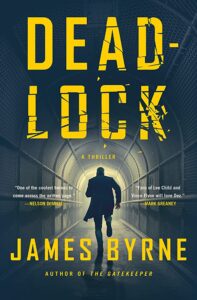There are several reasons why corporations and/or billionaire CEOs make such good villains in works of fiction. First, all mysteries and thrillers need a power imbalance favoring the bad guy. Second, because in real life, we keep seeing tech titans do reprehensible, insane and/or criminal things. And third, as Arthur C. Clarke told us, “Any sufficiently advanced technology is indistinguishable from magic.”
Let me take on that last one first: High tech corporations do stuff that, to a guy like me with a bachelor of arts degree in political science, is simply arcane. I read articles about, or ads for, Silicon Forest juggernauts and realize: I don’t know what any of those nouns and verbs mean.
And if you dabble in magic, well, you’re fair game to be the bad guy in a book or movie.
In the late 1970s, I was flying to see my family at Christmas in one of those awesome, 12-seat turboprop airplanes of the era. (This was the now long-forgotten Trans Magic Airlines. It wasn’t the world’s greatest airliner; we generally referred to it as Man’s Tragic Airlines.) The pilot, who sat two seats ahead of me, told us we had to make an unscheduled landing in Walla Walla. “Some engine problem.”
I asked him, “What’s wrong with the engine?”
He drawled, “Damned if I know.”
But a half hour later, he whistled for us to get back onboard and I did, along with the other passengers. Because with this mid-twentieth century technology, I felt safe to believe that this guy probably popped the hood, figured out what wasn’t working, and fixed it. I flew off without another thought.
If a pilot of a 747 today tells me there is engine trouble, I know beyond a shadow of a doubt that that pilot cannot fix the problem. It will require computers, diagnostic readouts, and a team of trained mechanics. The captain on the flight deck of a 21st century jetliner sure as hell isn’t popping the hood and digging around in the engine.
Because the workings of a jet engine today are sufficiently advanced—even to the captain—as to be is indistinguishable from magic.
It’s that unknown quality of the high-tech world that leads writers like me to create high-tech bad guys.
I don’t know what “the cloud” is but I store all my most valuable information there. Could it be used for crime in a novel? Sure, why not?
I don’t know how it is that two dudes’ will create a tech start-up in a rented office over an ampm minimart in Modesto and—without ever seeing the slightest profit—will suddenly get gobbled up for a couple of billion bucks. But it happens. Is that kind of inexplicable transfer of wealth a gold mine for mystery writers? Without a doubt.
Even the terminology is opaque to most of us. Ever read an articles about trolls doxing the netiquette of some cyberchondriac in the meatspace? Increasingly, articles about the high-tech world are devoid of English.
And even if you understand the words, their original meaning gets distorted. I saw an ad the other day for a tech firm that advertised they were “Calm Cool and Compliant.” Generally speaking, those are traits I look for in a hostage.
Writer Amelia Tait at Wired penned a terrific article recently titled, “The Rise of the Tech Bro Supervillain,” which featured a great line: “These days, evil wears a hoodie.”
If you’re about to start a new mystery or thriller novel and you need a bad guy, how could you not be influenced by Elon Musk? Beyond being a candidate for World’s Worst Boss, he recently crashed sentient cars, ginormous rockets and a social network. And that was on a Tuesday! Or Elizabeth Holmes, the former Theranos CEO whose golden parachute from that gig included 11 years in the slammer for defrauding investors. (There’s no rule that tech bros must be bros, per se.)
Edward Norton’s character, Miles Bron, in Rian Johnson’s delightful “Glass Onion” is the perfect example of the go-to bad guy. Breathtakingly full of himself, the dialogue of this chauvinistic, narcissistic rich boy was peppered with delightful malapropisms. Of course we all want to make fun of gigabyte gazillionaires! Or to be frightened by them.
The high-tech corporate cad isn’t a 21st century invention, by the way Hey, I learned to write action sequences by reading comics. From Superman’s Lex Luthor to Spider-Man’s Norman Osborn, ain’t nothing new in the CEO villain. Sure, very few writers today fall back on using the tried-and-true giant robot to dominate Metropolis, but our bad apples haven’t fallen that far from the tree of villainy.
Another reason for the Snidely Whiplashes of the C-Suite (wow, did I date myself with that one) is the much needed power imbalance that all good mysteries and thrillers must have. Simply put, the villain of the piece has to be sufficiently stronger than our heroine, right up until the end, that the threat is believable. Protagonists have to be underdogs. The fight has to be uphill, or it’s not such much a “thriller” as it is a “duller.”
Imagine a dust jacket that asks, “Will our hero, the assault-rifle-wielding gym-rat Special Forces icon, be able to defeat the cranky jerk threatening to write a snotty Yelp review in time?” The answer’s yes. That’s not a spoiler: you’ll have tossed out the book long before you get to the denouement.
Simply put: the ultra-rich make for good villains. The high-tech world is, for most of us, so opaque that Silicon Valley techno-mages are shovel-ready antagonists. And in real life, babbling billionaire buffoons keep showing us absolute power ain’t nothing compared to absolute wealth when it comes to corrupting absolutely.
Need a template for a bad guy in your next novel? Have you been on Twitter lately?
***


















